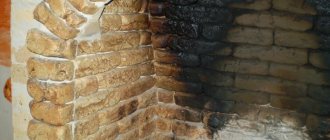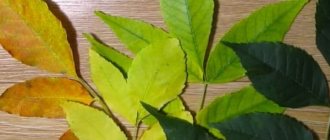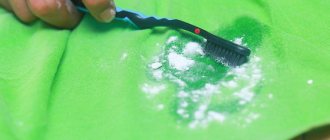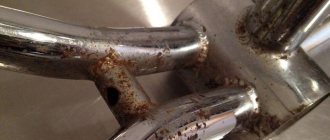Paint can get on clothes in different situations; you can get dirty on the street on a painted object or at work. Quite often children get dirty with it when drawing or on the street. And here questions arise about whether the stained item can be cleaned or whether it will have to be thrown away, and how to remove a paint stain from clothing. In fact, you shouldn’t be upset, since there are quite a few ways to remove such stains and they are all quite simple and accessible to all citizens.
Classification of stains by type of paint
In order to properly remove stains, you need to know what type of paint got on your clothes. So, there are such paints:
- drawing media – watercolor, gouache, tempera, oil. These products, as a rule, dissolve in water, and if you wash the stain as soon as it gets on your clothes, it will come off without a trace. This can be done either manually or in a washing machine. But in order to prevent the paint from eating into the fibers of the material, it is necessary to wash the item at a temperature of no more than 30 degrees. But it’s not always possible to wash soiled clothes right away. So, if the stain has already dried, you should first rub it with soap or apply a stain remover, or if the fabric is not delicate, you can heat vinegar and pour it over the contaminated surface. An hour after the selected procedure, the item can be washed. In cases with oil paints, use dishwashing detergent and stain remover to remove
- stamped. People who work with stamps and seals encounter stains from such paint; when refilling, they can drip onto their clothes. To remove such stains, you can use mustard and water mixed to a pulp, the resulting mixture is applied to the problem area for 24 hours, after which the dried mixture is cleaned off and the item is washed. Another option is a mixture of ammonia and turpentine in a 50/50 ratio; after applying it, the stain usually disappears and the clothes are washed;
- acrylic and latex paints. If this type of paint coating gets on your wardrobe items, you can resort to cleaning options used for gouache or watercolor. If the stains are large, then before removing them, you need to rinse them with cold water, then rub them in with a toothbrush, or washing powder, or dishwashing detergent and wash the water-based paint and clean it off in a similar way;
- alkyd (enamel and oil). This paint does not dissolve in water and therefore you must first remove it from the surface of the fabric; this can be done with the edge of a coin or the back of a knife. If the stain is fresh, then after removing the top layer, apply solvent or gasoline to the fabric; you can also use a mixture of acetone and gasoline (50/50). For old stains, make a mixture of turpentine, alcohol and gasoline, apply for an hour, then remove the top layer along with the paint and rinse the stain, then apply laundry soap and wash.
Attention: it must be remembered that the effectiveness will depend directly on what type of paint and varnish material got on the item.
Top 3 universal recipes
There are universal products that can be used in any situation, regardless of where exactly the oil paint ended up.
Laundry soap
The product contains acids, alkalis and fats. These three components are excellent at breaking down oil compounds.
Mode of application:
- Moisten the item that has the stain.
- Lather the soap.
- Apply it to the contaminated area.
- If the paint has dried, then leave the foam for 5-10 minutes to act.
- Rub the contaminated surface.
- Rinse off the composition with water.
Soap can be safely used on human skin; it can be used to wash various fabrics and clean wooden and plastic surfaces.
Petrol
This petroleum product has the property of destroying paint molecules. Use it as follows:
- apply the composition to a cloth or cotton pad;
- wipe the stain;
- remove gasoline residues with paper napkins;
- wash the treated surface with water.
Butter combined with washing powder
The oil breaks down the paint molecules, and the detergent allows you to wash out the fatty component and pigment.
Mode of application:
Prepare a paste based on oil and powder.- Apply it to the stain.
- Leave for 10-30 minutes.
- Remove the composition with a paper napkin.
- Clean off any remaining paint with a brush.
- Rinse the treated area with hot water.
The sooner treatment begins, the easier it is to deal with the paint.
Ways to remove paint from clothes at home
Having understood what kind of paint got on the wardrobe item, the housewife can choose the appropriate option to effectively remove the contaminated area. It could be:
- mechanical;
- technical;
- or chemical method.
Traditional methods are quite common and effective methods, for example, you can remove dirt by mixing lemon and hydrogen peroxide (1 lemon 1 tablespoon of peroxide), a similar mixture should be applied to the contaminated area and washed after an hour. Another option is to apply alcohol or acetone to the stain until the paint comes off completely.
In order to get a positive result when cleaning surfaces from paint and varnish materials, you must follow some rules:
- removal actions should be carried out as quickly as possible; do not wait for drying, as this complicates the cleaning process;
- to avoid staining the second sati of the item, you should place a piece of fabric, paper, etc. under the resulting stain;
- Before applying to a stained area, it is worth pre-treating the surface in an inconspicuous place to see how the fabric reacts, as the substance can be harmful, discolor or dissolve the fibers of the material
- If you use cotton pads, a sponge or pieces of material when cleaning, you must change them as often as possible. Cleaning movements should be made from the edge to the middle of the existing contamination
- After all actions, you need to rinse thoroughly, and then wash by hand or in a washing machine with the addition of soap.
Attention: sometimes it is not possible to remove the contamination the first time. Therefore, you can use several options, although each of them must be suitable for the fabric from which it is being removed. But you should always consider the material from which the stain will be removed to avoid damaging the fabric.
Mechanical
This removal method is suitable for dense fabrics, since thin fabrics can simply be damaged. So, the mechanical method consists of using foreign objects that can be quite sharp (blades, knives, etc.), so the paint is cut off from the plane. This should be done carefully so as not to damage the fibers.
Thermal
Thermal removal can be carried out both at enterprises and at home. Under the influence of hot air or steam, the paint peels off from the surface. When using this method, you should follow safety rules to avoid getting burned. The process consists of heating the garment to a temperature at which the ink melts and becomes more flexible. Next, take an object resembling a spatula and carefully remove the layer. Removing acrylic paint at home is quite simple, you should first apply a soap solution to the problematic area and then heat it, this can be done with a hairdryer. Window or plumbing cleaner will help remove acrylic paint from fabric that has penetrated deep into the dirt.
Chemical
To rid surfaces of this type of contamination, a lady usually uses a chemical option. But when choosing this method, you should take into account the type of material on which the contamination appeared and choose the right removal agent. It is also necessary to take precautions, wear gloves, they will save your hands from possible damage to the skin. If the contaminated area is large and requires the application of more solvent, then you should also protect your respiratory tract and use a respirator and goggles to avoid the loss of vapors or splashes into the eyes.
The room must be regularly ventilated, as such removal products can be toxic.
Attention: even exposure to chemicals may be useless if the contamination is very old.
Thermal effects: hair dryer, iron
This option is used as standard to clean wooden substrates. It is required to heat the paint surface using a hair dryer or a blowtorch; heat it in zones. The temperature effect involves bringing the base to 120-150 degrees. If bubbles appear on the layer, you can turn off the device. You need to clean the layer with a spatula.
But there are some prohibitions when using the method:
- Do not heat the surface in areas where electrical wiring passes; the wires may melt from such an action;
- Also, working near electrical fittings is prohibited.
In order not to overheat the layer, you need to monitor the degree of heating, otherwise you can stick the heated paint to the base, and then it will not be able to wipe off. When working, the paint will release toxic substances, so create ventilation in the room and wear a respirator.
This option is used as standard to clean wooden substrates.
Removing paint from various surfaces
In addition to fabric, there are other planes from which it is sometimes necessary to remove fallen or previously applied paint and varnish products. These surfaces include:
- tree;
- iron;
- concrete;
- glass, etc.
The product is selected depending on the applied paint layer and the removal method and the product itself are selected.
How to remove old paint from a wooden surface is a question that may arise, for example, when repairing a wooden shop door or when renovating an apartment, intending to remove old paint from a wooden floor. To remove old wood from wood, a mechanical cleaning option is used, since it can withstand different forces of impact on it.
For coverings such as carpets, a chemical cleaning option is suitable, that is, the use of various chemicals such as linseed oil. It is suitable due to the fact that it is easier to remove due to its composition.
To remove from metal surfaces, a chemical composition is also used; it is applied with a brush and left for the period of time indicated in the package; paint is removed from plastic in a similar way.
For example, how to remove paint from jeans? To remove dye from jeans at home, you can use both mechanical and chemical methods, since the fabric is dense and both options are suitable.
The mechanical removal method is suitable for removing from metal or other hard surfaces, for example, for iron and removal from wood, it can be done with sandpaper or a special attachment that is put on an angle grinder.
To understand how to remove old paint from metal, you need to pay attention to how many layers were applied. If there are a lot of them, then you can resort to the mechanical method, only for this you should use a grinder with a special attachment.
Important Tips
When removing oil paints, you should adhere to the following recommendations:
Consider the type of surface. The method of removing the coloring composition will depend on this.- Protect respiratory organs, skin of hands and mucous membranes when working with chemical compounds.
- Ventilate the room if the cleaning product has a pungent odor.
- Before using the new composition for the first time, test it on a small area.
- Before removing paint, remove dust and other contaminants from the surface.
When working with removers and caustic substances, it is advisable to use glass containers. Not all materials can withstand the effects of chemicals.
In the future, such containers must be disposed of. Food cannot be stored in them.
Thinner for paints and drying oils
Solvents are used for thickened and dried paint and will help remove it by liquefying it.
Depending on the type of paint, solvents are also used; there are several subtypes of coloring materials:
- paints intended for household needs, that is, needed for application to the surfaces of buildings or objects
- used for art, that is, those used to draw.
So, to transform the coloring material into a more liquid state, you can use the following types of solvent:
- turpentine;
- White Spirit;
- drying oil oxol;
- gasoline or kerosene and many others.
If you are going to clean paint from a fabric surface, linseed oil drying oil is a good choice, as it is quite easy to remove from the material.
Removing stains from fabric surfaces is a procedure that requires care to avoid damaging it. You should also determine the type of paint stain, this will help you choose the right method and means for removal.











